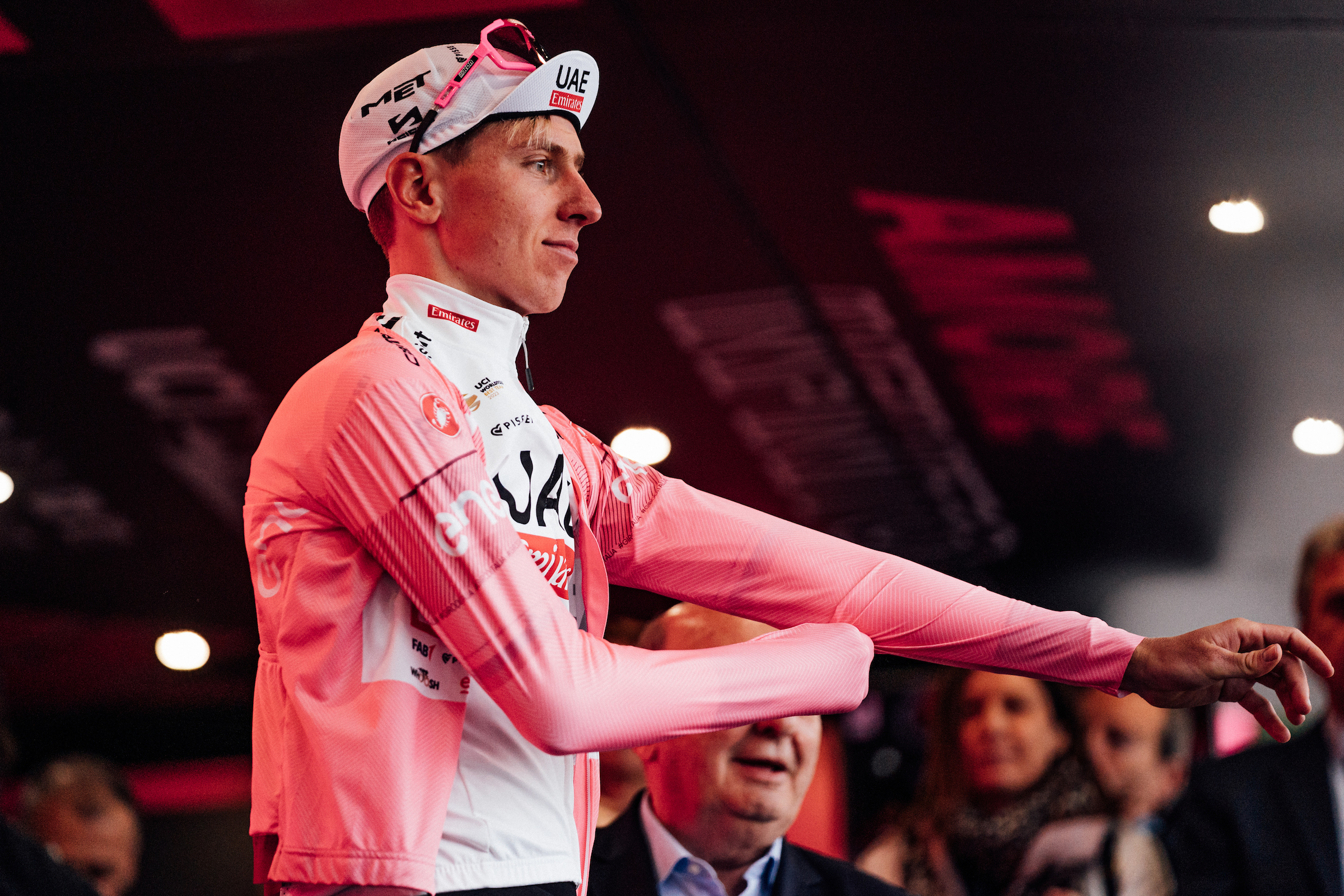Which Pogačar was everyone expecting?
Cyclingnews columnist Philippa York looks at the options for Pogacar's GC rivals

Which Tadej Pogačar were his fellow competitors expecting at the Giro d'Italia? The favourite who waits for the decisive moments in the mountains, the opportunist who seizes any advantage, the one who is patient and only expends energy when he needs to, or the usual Tadej for whom a bike race is fun, fun, fun?
After just four stages it’s fair to say that all of them have occurred and we haven’t even gotten to the time trials yet. If ever there was any confusion on how to deal with the UAE leader then he’s added a whole lot more to the equation.
The usual tactics for the contenders in a Grand Tour are to stay out of trouble and do as little as possible in the first week, maintain or improve position during the second phase, and into the last seven stages either defend or attack depending on what has happened up until then.
Therefore Pogačar’s acceleration on the final climb of stage one was rather unexpected, not totally but certainly surprising given that it was the first day. He subsequently said he wanted to dedicate the win to the young rider from his academy who had died in a kayaking accident, but the idea of being in the maglia rosa from start to finish must have been in the back of his mind too.
The following day to Oropa with the Pantani-esque drama of having an incident at the beginning of the climb provided a few doubts, but by the midway point, the ominous signs of complete control were back. Rafael Majka upped the pace to warp speed and only Ben O’Connor tried and failed to follow. Maybe the Aussie ought to have known better. However, there’s merit in trying and it was a lesson learnt, namely stick to what you know you can do. That, and to only race against Pogačar when he has less to prove. The scrambling behind established a preliminary tier of contenders for the podium places alongside the new race leader.
Pogačar’s status as the outright Giro d'Italia favourite was confirmed and though there’s some speculation on how he might be less protected in the bigger mountains at the moment, he is a level above everyone else. Just ask Geraint Thomas, who felt the pain the next day when Pogačar decided it was worth a little effort to follow a late attack by Michel Honoré. We saw power-a-plenty for the pink jersey and a warning for what is to come.
Everyone needs to pay attention all day, every day, because until he decides he has done enough to relax, Pogačar is going to race for seconds here, there and everywhere. I get the feeling he is going to mix up his tactics to suit his mood, or if the opportunity comes along and once he has a decent lead, he’ll knock it off a touch and save energy for the Tour de France. He’ll take something like a four-minute lead after the next weekend and then add the same again to go into the last phase when he could content himself with following his rivals and taking stage wins if possible.
Get The Leadout Newsletter
The latest race content, interviews, features, reviews and expert buying guides, direct to your inbox!
The gravel stage that’s coming won’t worry UAE much – certainly not like it will for others in the peloton. Geraint Thomas has been vigilant and well placed by an Ineos team that looks more solid than its last few showings at WorldTour stage races, so he has the backup if something does go wrong. Sadly he has a bit of a record of mishaps, so lets hope luck is with the Welshman this time.
A look through the GC riders that are roughly inside 90 seconds of the lead hasn’t revealed much that we didn’t know already. From Dani Martinez down to Alexey Lutsenko, it’s going to be a game of snakes and ladders over the coming stages. Martinez’s grinta will see him good and Thomas will do what he always does, ride to his plan, not go into the red too often and if possible outlast the rest. For the others, like Cian Uijtdebroeks, Einer Rubio and Juan Pedro Lopez, the lessons of riding a Grand Tour as a GC contender are starting in earnest.
Uijtdebroeks is in the least comfortable position as far as stress is concerned. Racing for Visma-Lease a Bike comes with expectations. He has already found himself on the wrong side of splits in the peloton which required the sacrifices of Olav Kooij’s sprint train. It’s a scare that has proven his responsibilities: stay in the front with your rivals.
Italian fans will be watching to see what Lorenzo Fortunato can do in the mountains now he’s stepped up to a WorldTour team. As a former winner on Monte Zoncolan he also has something to prove.
Of the three Australians who have said they are here for the GC, so far Michael Storer and Ben O’Connor look to be in shape, but Luke Plapp has been lurking at the back too much if he’s serious about any chance of a top-ten.
Further playing to UAE’s favour is the sheer number of sprinters present. That’s because it means there are a lot of days where they don’t have to control breakaways. Almost every WorldTour team has brought their fast man so the final kilometres are extra hectic – they always are at the Giro anyway – and until a clear hierarchy emerges then it’s pretty dangerous. Adding to the street furniture and sketchy corners, I see far too many parked cars on the sides of the road inside the last hour for my liking and it’s something RCS, the organisers, need to improve.
Another thing cycling needs to sort out is communication and how it presents itself. Only at the Giro could you have the race leader being pulled up for the wrong outfit. The rules say you have to wear the jersey provided by the race organisation if you are leading a classification, and if you don’t, you get fined. Therefore why on earth are the UCI commissaires saying to Tadej Pogačar he has the wrong coloured shorts on his skinsuit? And what’s more, that he’ll be punished if he does it again. The outfit was issued by RCS, no less. Someone, somewhere, interpreted the regulations and thought pink and purple was a good combination. Apparently, it wasn’t purple but ’granata’, which translates as garnet (a gemstone) in English, but can also mean grenade.
It certainly had the effect of throwing a small bomb at the idea of Italians being fashionable.
Philippa York is a long-standing Cyclingnews contributor, providing expert racing analysis. As one of the early British racers to take the plunge and relocate to France with the famed ACBB club in the 1980's, she was the inspiration for a generation of racing cyclists – and cycling fans – from the UK.
The Glaswegian gained a contract with Peugeot in 1980, making her Tour de France debut in 1983 and taking a solo win in Bagnères-de-Luchon in the Pyrenees, the mountain range which would prove a happy hunting ground throughout her Tour career.
The following year's race would prove to be one of her finest seasons, becoming the first rider from the UK to win the polka dot jersey at the Tour, whilst also becoming Britain's highest-ever placed GC finisher with 4th spot.
She finished runner-up at the Vuelta a España in 1985 and 1986, to Pedro Delgado and Álvaro Pino respectively, and at the Giro d'Italia in 1987. Stage race victories include the Volta a Catalunya (1985), Tour of Britain (1989) and Critérium du Dauphiné Libéré (1990). York retired from professional cycling as reigning British champion following the collapse of Le Groupement in 1995.
